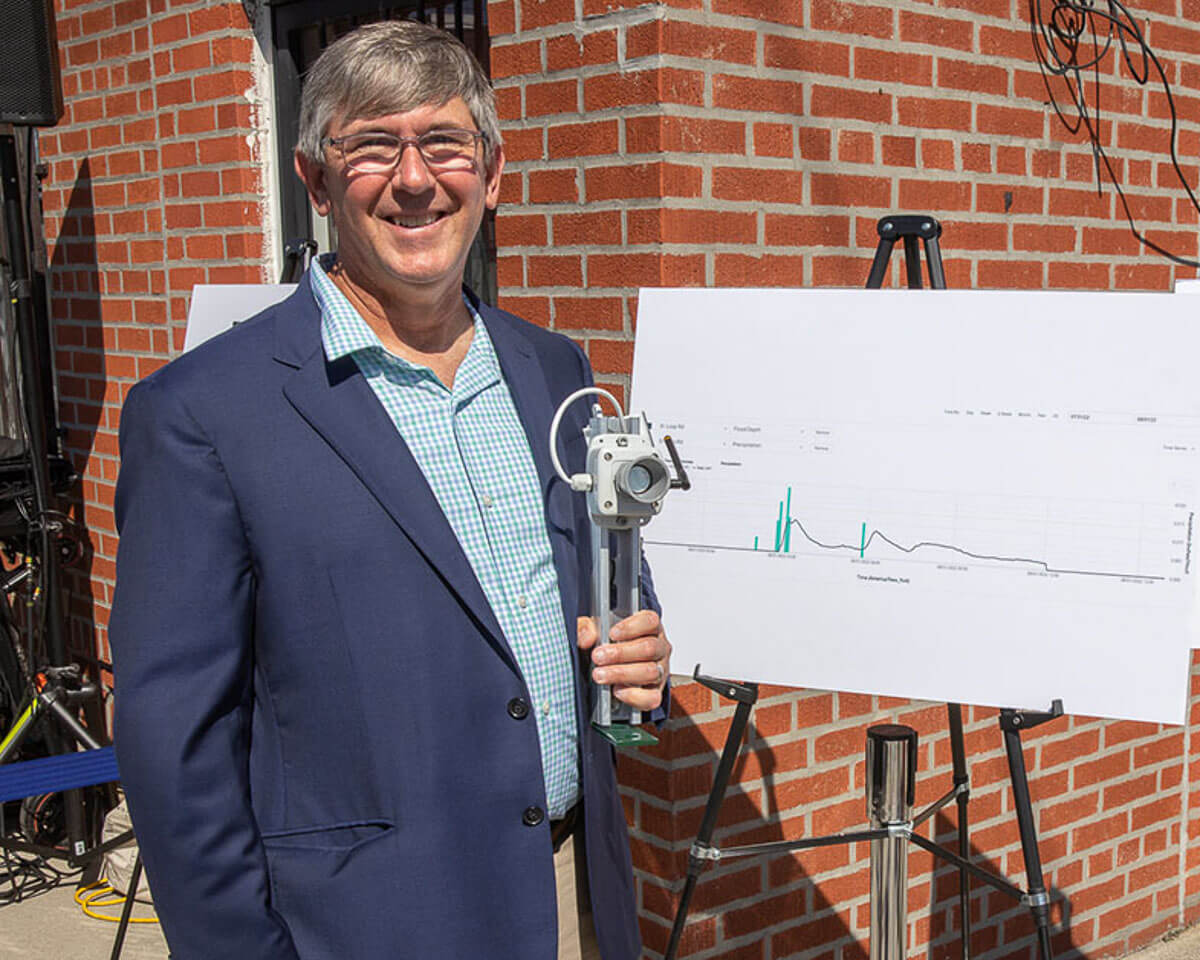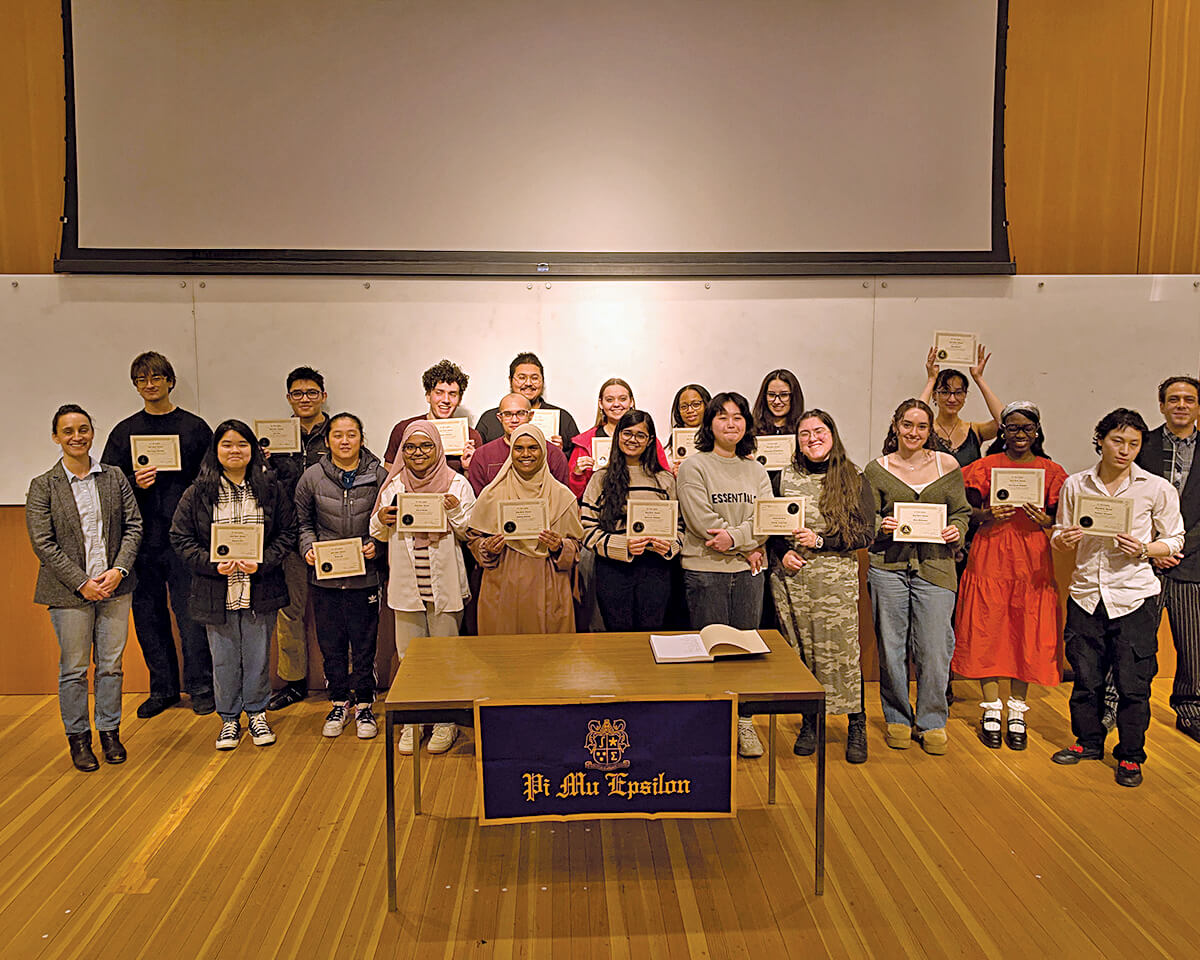
Brett Branco stands with a sensor and a data board with Rebecca Fischman, Senior Policy Advisor from the Mayor’s Office of Climate and Environmental Justice, on September 1 where Mayor Eric Adams announced various stormwater infrastructure initiatives aimed at making the city more resilient to extreme rainfall in the future.
New York City is girding itself for storm season, which, in the face of accelerating climate change, could mean more frequent and extreme storms like Hurricanes Henri and Ida as well as local cloudbursts producing prodigious volumes of stormwater.
Brett Branco from the Department of Earth and Environmental Sciences and the Executive Director of the Science and Resilience Institute at Jamaica Bay at Brooklyn College who also teaches at the CUNY Graduate Center is part of an academic, government, and community consortium called FloodNet that is addressing these issues through a first-ever, free online tool that will help communities and government agencies to know where, when, and how quickly flood waters are rising.
Launched on Sept. 1—the one-year anniversary of the devastating and deadly flooding from Hurricane Ida—the new mobile-ready web dashboard presents real-time data collected by the expanding FloodNet system of low-cost, open-source sensors in flood-prone areas across the city. Currently, FloodNet comprises 30 ultrasonic devices deployed in Brooklyn, the Bronx, Manhattan, Queens, and Staten Island, from which readings are delivered to an interactive map and data visualization platform that allows users to see the occurrence and depth of flood water at each sensor location.

Brett Branco stands at a FloodNet sensor in Hamilton Beach, Queens.
“We’ve been working with both communities and government for years to better understand the impact that flooding has on the lives of NYC residents,” Branco said. “From the frequent nuisance flooding due to high tides around Jamaica Bay, to the catastrophic flooding across all five boroughs that occurs during coastal storms and extreme rainfall events, FloodNet and the data dashboard will help NYC find equitable solutions to these problems.”
New York City Mayor Eric Adams and the New York City Department of Environmental Protection marked the one-year anniversary of Hurricane Ida today in Queens by announcing a suite of stormwater infrastructure initiatives aimed at making the city more resilient to extreme rainfall in the future, including the FloodNet sensors and the newly launched dashboard. The city has already installed 29 sensors this year alone and will install 50 this year and 500 FloodNet sensors in priority areas citywide over the next five years. These areas are and will continue to be determined by an analysis of stormwater risk, tidal flooding risk, storm damage, environmental justice history, social vulnerability, critical infrastructure, and proximity to wireless network connections.

Mayor Eric Adams holds up a FloodNet sensor at his press conference on September 1 in Queens.
“I’m a big believer in technology to run our city smarter,” Mayor Adams said, adding that the sensors and dashboard will provide the city with critical infrastructure in order to advice evacuations, travel bans, or road closures. “This is more than infrastructure; it’s how we are going to protect our city and people from rising sea levels and stronger storms,” he said. “This is how we are going to lead. Everyone takes notice of what happens here in New York and what happens here cascades to the rest of the country.”
The dashboard is free-to-use and makes it easy for communities and government agencies to know where, when, and how quickly flood waters are rising, either from overburdened stormwater drains or coastal seawater surges. The system was created in partnership with FieldKit, with funding from the New York State Empire State Development Corporation.
The research team also includes Ricardo Toledo-Crow of CUNY ASRC, CUNY Advanced Science Research Center (ASRC), the NYU Tandon School of Engineering, the NYC Mayor’s Office of Climate & Environmental Justice, and the NYC Office of Technology & Innovation. It was developed by a team of researchers including Branco, Andrea Silverman, Charlie Mydlarz, Tega Brain, and Elizabeth Hénaff of NYU Tandon.
The dashboard:
- Displays a rich data set collected by the FloodNet sensors, including the depth and profile of street-level floods over time, which can be of use to community members, city agencies, researchers, emergency responders, journalists, and others.
- Provides flood data in real-time as they are collected, and can alert users to floods as they develop.
- Includes a searchable map view that allows users to see at a glance which sensors are currently recording floods.
- Includes historical data, allowing users to explore and understand the frequency and severity of flooding in locations where FloodNet sensors are deployed, in addition to visualizing floods that occurred during specific events. For example, during Tropical Storm Henri, FloodNet sensors deployed in the Gowanus neighborhood in Brooklyn recorded two distinct flood events on the same night separated by an hour where the water receded. During Ida, sensors recorded three feet of flooding at the intersection of Carroll Street and 4th Avenue in Brooklyn, with flood waters rising quickly, peaking within 20 minutes, creating extremely hazardous conditions.
- Visualizes regular flooding related to high tide events through data collected by flood sensors deployed in coastal neighborhoods.
“This is the first time that quantitative data on urban flood occurrence, depth, and duration have been measured and provided to the public — we’re excited to share the dashboard with communities, city agency partners, and other researchers,” said Silverman, an assistant professor of environmental engineering at NYU. “We’ve heard many stories and desired use cases for the data from a variety of stakeholders, and are looking forward to seeing how these communities end up using the real-time and historic flood data.”
The FloodNet project overall was developed as a collaboration between researchers at the Science and Resilience Institute at Jamaica Bay (SRIJB) at Brooklyn College, NYU Tandon’s Center for Urban Science and Progress (CUSP), and the Advanced Science Research Center at the CUNY Graduate Center (CUNY ASRC), in partnership with the NYC Mayor’s Office of Climate & Environmental Justice and the NYC Office of Technology & Innovation and with the financial support of the C2SMART Tier 1 U.S. Department of Transportation University Transportation Center at NYU Tandon, the NYU Marron Institute, and the CUNY Office of Research.
“An exciting aspect of the Floodnet project is that we’re also using it to train the next generation of young environmental scientist and community-based stewards through the involvement of New York City-based high school, community college, and undergraduate students who help us assemble, install and maintain the sensors,” said Toledo-Crow, director of the ASRC Next Generation Environmental Sensors Lab, who helped design the sensors.
About Brooklyn College
Widely known for its offer of an excellent education at an affordable tuition and recognized nationally for its diverse student body, Brooklyn College has been an anchor institution within the borough of Brooklyn and greater New York City for more than 90 years. With approximately 16,000 students in more than 100 undergraduate and graduate degree programs in the arts, humanities, sciences, education, and business, the college is renowned for its rigorous academics, award-winning faculty, distinguished alumni, and community impact. Part of the City University of New York (CUNY), Brooklyn College offers a vibrant and supportive student experience on a beautifully landscaped 35-acre campus in the borough’s Midwood neighborhood.



